Texting is easily Gen Z’s preferred communication method and a powerful way to engage prospective students.
- 75% would rather text than talk, according to a LivePerson survey of Gen Z and Millennials.
- Gen Z is also three times more likely to open a text than an email.
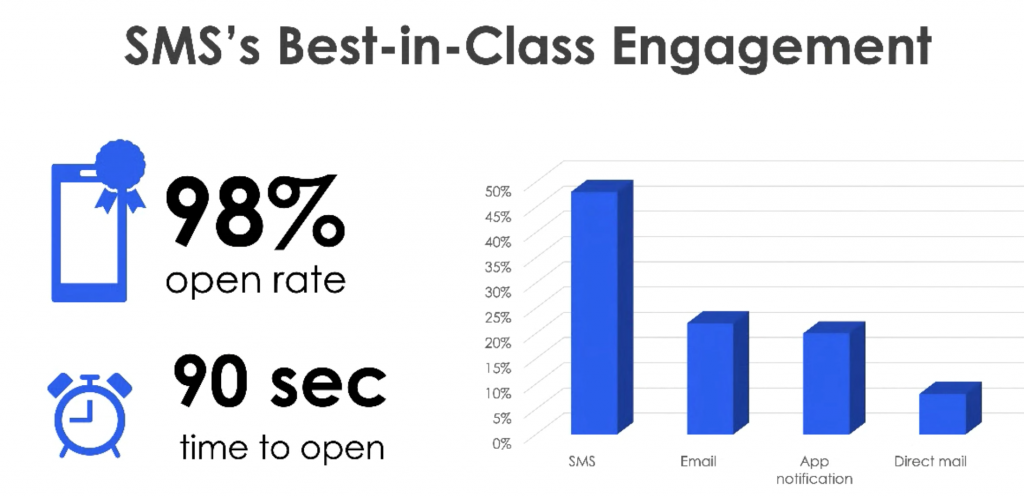
College texting reaches prospects more quickly and effectively than other platforms.
Addressing needs at each stage of the admissions journey with texting
Texting can help your college develop relationships with prospects throughout the student’s decision-making process by addressing specific needs and concerns. Texts can also urge specific actions at specific times.
Texting can help position your school as a valuable resource and build trust with prospective students. College texting can:
- Communicate important information, such as deadlines
- Provide application resources
- Answer questions quickly and effectively
- Celebrate admitted students
College texting is also beneficial to staff and leadership, who need ways to streamline communication and collect data. Strategically planned texts help staff:
- Reduce number of phone calls and emails
- Quickly identify student concerns
- Collect useful insight on student engagement
- Pinpoint areas for process improvement
4 smart college texting tips
Prospects respond best to clear, positive communication tailored to specific needs. The following best practices can help nurture prospective student relationships—and spur action:
- Make taking action easy
Reduce potential barriers by including links and direct contact information. - Include specific calls to action
Build a sense of urgency by highlighting deadlines and explicit next steps. - Offer supplemental information
Cross-market different opportunities for engagement. If a prospect declines an invitation, offer a relevant alternative. - Employ a positive and friendly tone
Adopt a welcoming and congenial tone to reinforce positive brand perception—and build trust with prospects. Use exclamation points and emojis to convey friendliness.
Texting throughout the admissions journey

When crafting a college texting strategy, align messages with each stage of the admissions funnel. This approach ensures leads are nurtured throughout the admissions journey, from prospective to enrolled student.
An integrated approach also prioritizes personalization—a key tactic for reaching Gen Z. Messages are automatically tailored to the student’s needs at a specific point in time.
Below, we recommend content for each stage of the admissions journey, with different examples to illustrate the approach.
Prospects
Prospects are just starting to explore your school’s offerings. Beginning communication early offers a valuable opportunity to shape your brand.
Prioritize content that offers learning and relationship-building opportunities. Demonstrate the impact of your programs through stories or statistics which demonstrate student outcomes.
The content might include:
- Invitations to school information sessions
- Ways to connect with current students
- Alumni success stories
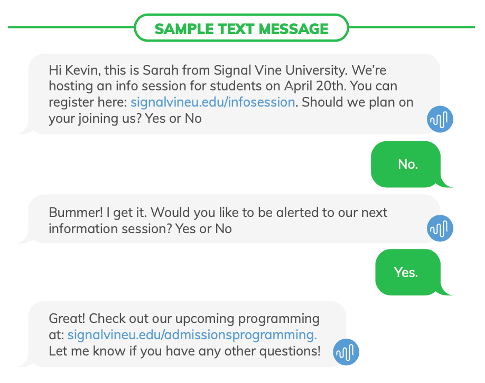
This sample text markets an upcoming info session, offering prospects an interactive chance to learn more about (the fictitious) Signal Vine University (SVU). Signal Vine provides the registration link and an easy way to confirm (Yes or No). SVU also provides upcoming event information – and does so with a positive and inviting tone.
Inquiries and applicants
During the inquiry stage, build on your initial strategy by sharing ways to engage and learn more. Consider extending invitations to:
- In-person or virtual open houses
- Program-specific webinars
- Free college counseling appointments
Mine additional personal details to help personalize future messaging. Strategies include texting more targeted questions or requiring details for event registration (think: lead generation).
In the applicant stage, focus on guiding students through the application process. Consider breaking your process into mini pieces, then build messaging to address each step. Be sure to include deadlines and follow-up if applicants don’t respond.
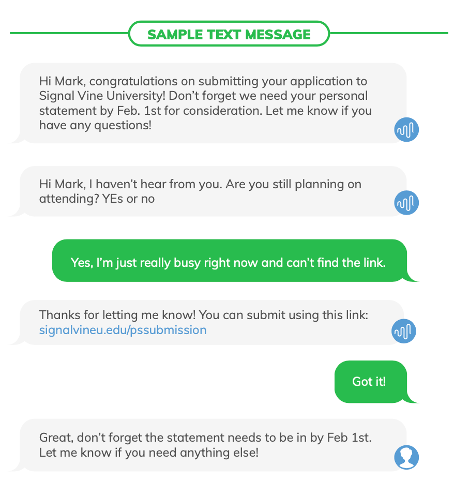
Signal Vine checks in with Mark, a new applicant, with a deadline reminder for his application. When he doesn’t respond, SVU sends a second message. The school provides a link for easy access and a deadline reminder at the end to help build urgency in response.
Admitted and enrolled
The admitted stage is an opportunity for celebration and comradery—and for next steps. Consider texting to:
- Congratulate and welcome accepted students
- Break down registration process steps
- Provide contact info for questions
The admitted stage is also a good opportunity to learn more about students who do not attend. If a student indicates non-enrollment, ask why.
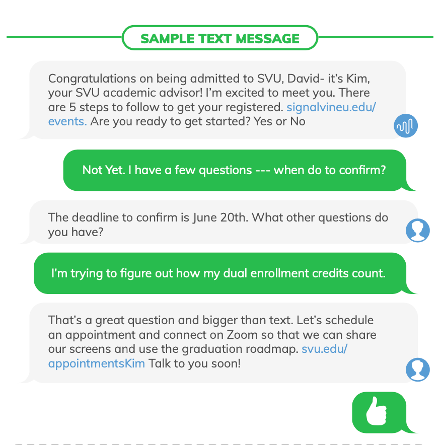
SVU’s academic advisor checks in with David, an admitted student, to outline the five registration steps. She communicates the registration deadline and helps address David’s concern about dual enrollment credits.
Lastly, in the enrollment stage, focus on conveying important next steps through links and contextual information. Content might include:
- Information on FAFSA and scholarships
- Orientation details
- Deposit deadlines
- Next steps for housing
Hone your college texting strategy
After you’ve piloted college texting, set a regular cadence for evaluation. Like any marketing initiative, you’ll want to track results and adjust as knowledge evolves.
Consider the following tactics to deepen your strategy.
Coordinate across departments
Be sure to coordinate with other departments which also use college texting. Nothing deters prospects more than receiving multiple, repeated text messages.
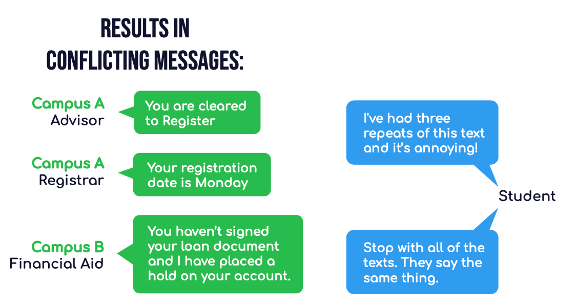
Signal Vine demonstrates the impact of un-coordinated college texting on an admitted student.
Set regular meetings to discuss goals, content, and timing. Aim for an integrated texting plan which supports multiple department goals.
Give a heads up
Let prospects know you’ll be sending texts. Setting expectations helps build trust and demonstrates respect—two important lead nurturing strategies. Offering a “heads up” also helps build a college texting-friendly culture by normalizing usage.
Consider adding a college texting blurb to:
- Staff email signatures
- Social media profiles
- Marketing collateral
- Program webpages
Offer an SMS hotline
During particularly busy periods (like when applications are due) consider creating an SMS hotline. Employ a single phone number for students to text questions. SMS Hotlines can help streamline and simplify communication—and ensure questions are answered quickly.
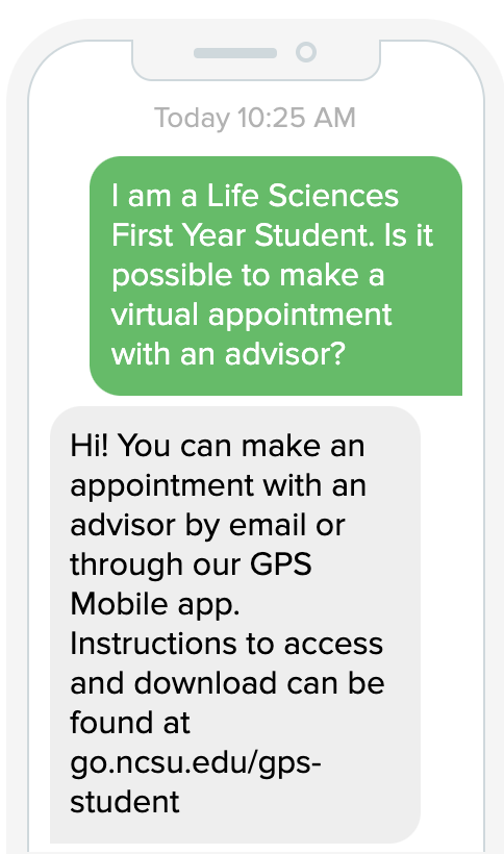
Here’s the story of how NC State managed their SMS hotline during student orientation (which includes the example above).
Use personas to personalize
If available, use student personas to inform your evolving messaging strategy. Personas provide valuable insight into students’ motivations, essential data for personalizing content. Use persona data—including demographic information, goals, and go-to information sources—to help answer questions like:
A powerful lead nurturing tool
With the right approach, college texting is a powerful lead nurturing tool. By aligning with the admissions journey—and employing tools like marketing automation—colleges can use texting to drive enrollment and build lucrative student relationships.
Note: A shout out to SignalVine, whose excellent ebook inspired many of the ideas here, and is the source of several sample texts shown above.








